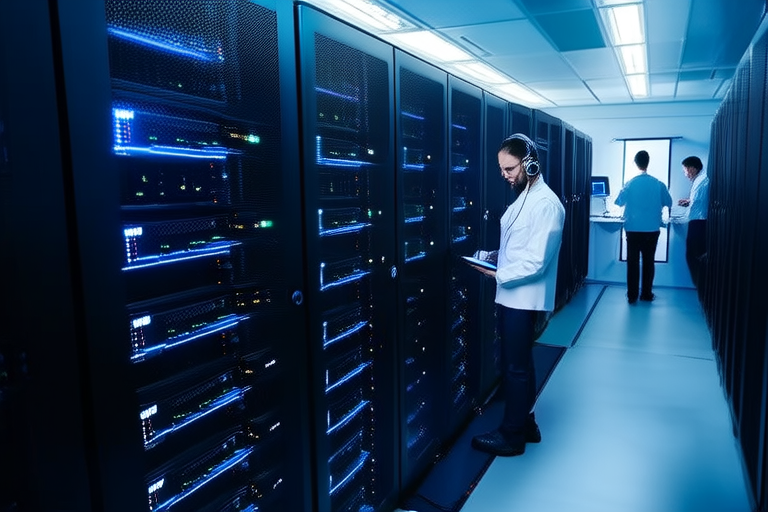“`html
The Intersection of AI and ML: Innovations Driving the Next Wave of Automation
Introduction
Artificial Intelligence (AI) and Machine Learning (ML) are two of the most transformative technologies of our time. While often used interchangeably, they represent distinct but interconnected fields within the broader domain of computational intelligence. AI refers to the simulation of human intelligence in machines that are programmed to think, learn, and perform tasks that typically require human intelligence. Machine Learning, a subset of AI, focuses on the development of algorithms that enable systems to learn from data, identify patterns, and make decisions with minimal human intervention.
The intersection of AI and ML is particularly crucial because they complement each other in ways that enhance their capabilities. As AI systems become more sophisticated, ML provides the means for these systems to continuously improve through experience. This synergy is driving the next wave of automation, promising significant advancements across numerous industries. The convergence of these technologies is not just about automating repetitive tasks; it’s about enabling smarter, more efficient, and adaptive systems that can handle complex decision-making processes.
In this article, we will explore the foundational concepts of AI and ML, examine their intersection, discuss recent innovations, and analyze how these advancements are fueling the next phase of automation. We’ll also address the challenges and opportunities associated with integrating AI and ML into existing processes and conclude with a forward-looking perspective on the future of these technologies.
Key Concepts
Understanding AI and ML
Artificial Intelligence (AI) encompasses a wide range of technologies designed to simulate human cognitive functions. These include reasoning, problem-solving, perception, and language understanding. AI can be categorized into narrow AI, which is designed for specific tasks, and general AI, which aims to replicate human-level intelligence across all domains.
Machine Learning (ML), on the other hand, is a subset of AI that involves the development of algorithms and statistical models that allow computers to learn from and make predictions based on data. Unlike traditional rule-based systems, ML algorithms improve automatically through experience, making them highly adaptable to new situations.
While AI focuses on building intelligent systems, ML provides the tools and techniques for these systems to learn from data. This distinction is important because it highlights the iterative nature of ML, where systems continuously refine their performance as they encounter more data.
The Intersection of AI and ML
The intersection of AI and ML lies in their ability to work together to create intelligent systems capable of performing complex tasks. For example, AI can be used to develop algorithms that recognize patterns in large datasets, while ML provides the mechanisms for these algorithms to learn and adapt over time.
One of the most prominent examples of this synergy is seen in the field of autonomous vehicles. AI is used to interpret sensor data and make real-time decisions, while ML algorithms continuously refine these decisions based on new data. This collaboration enables self-driving cars to navigate safely and efficiently in diverse environments.
Another area where AI and ML intersect is in natural language processing (NLP). NLP systems use AI to understand and generate human language, while ML algorithms improve the accuracy and fluency of these systems by learning from vast amounts of text data. This combination has led to the development of advanced chatbots and virtual assistants that can engage in meaningful conversations with users.
Innovations in AI and ML
Recent advancements in AI and ML have transformed various industries, opening up new possibilities for innovation and automation. Some of the key innovations include:
- Deep Learning: A subfield of ML that uses artificial neural networks with many layers to model complex patterns in data. Deep learning has revolutionized image and speech recognition, leading to significant improvements in computer vision and voice recognition technologies.
- Neural Networks: Inspired by the structure and function of the human brain, neural networks consist of interconnected nodes that process information. They are particularly effective for tasks involving pattern recognition and classification.
- Natural Language Processing (NLP): NLP enables machines to understand, interpret, and generate human language. Advances in NLP have led to the development of sophisticated chatbots, translation services, and sentiment analysis tools.
- Computer Vision: Computer vision involves teaching machines to interpret and understand visual information from the world. It has applications in areas such as facial recognition, object detection, and medical imaging.
These innovations are not only improving existing technologies but also enabling entirely new applications. For instance, deep learning has been instrumental in developing AI-driven medical diagnosis systems that can analyze medical images and detect diseases with high accuracy. Similarly, advances in NLP have made it possible for virtual assistants to understand and respond to user queries in natural language.
Driving the Next Wave of Automation
The innovations in AI and ML are fueling the next phase of automation across various sectors, including manufacturing, healthcare, finance, and transportation. In manufacturing, AI and ML are being used to optimize production processes, predict equipment failures, and improve quality control. For example, predictive maintenance systems use machine learning algorithms to analyze sensor data and anticipate when machinery needs repair, reducing downtime and increasing efficiency.
In healthcare, AI and ML are transforming patient care by enabling more accurate diagnoses, personalized treatment plans, and better disease management. For instance, AI-powered diagnostic tools can analyze medical images and detect abnormalities with greater precision than human radiologists. Additionally, ML algorithms are being used to analyze electronic health records and identify patients at risk for certain conditions, allowing for early intervention.
In finance, AI and ML are revolutionizing fraud detection, risk assessment, and customer service. For example, AI-driven fraud detection systems can analyze transaction patterns in real-time and flag suspicious activities, preventing financial losses. Similarly, ML algorithms are being used to assess credit risk and provide personalized recommendations to customers.
In transportation, AI and ML are driving the development of autonomous vehicles, smart traffic management systems, and optimized logistics solutions. Autonomous vehicles rely on AI to interpret sensor data and make real-time decisions, while ML algorithms continuously refine these decisions based on new data. Smart traffic management systems use AI to optimize traffic flow and reduce congestion, while ML algorithms are being used to optimize delivery routes and improve supply chain efficiency.
Case studies from these sectors illustrate the transformative impact of AI and ML on automation. For example, a major automotive manufacturer implemented an AI-driven predictive maintenance system that reduced unplanned downtime by 30% and increased overall equipment effectiveness by 20%. Similarly, a leading healthcare provider deployed an AI-powered diagnostic tool that improved the accuracy of cancer diagnoses by 15%, leading to better patient outcomes.
The potential future implications of these advancements are profound. As AI and ML continue to evolve, they will likely enable even more sophisticated automation, leading to further productivity gains and cost savings. However, there are also challenges and risks associated with these technologies, including ethical considerations, data privacy concerns, and workforce displacement.
Challenges and Opportunities
Despite the many benefits of AI and ML, businesses and organizations face several challenges in adopting these technologies. One of the primary challenges is the need for high-quality data. AI and ML systems require large amounts of accurate and relevant data to learn effectively. Ensuring data quality and availability can be difficult, especially for organizations with limited resources.
Another challenge is the integration of AI and ML into existing processes. Many organizations struggle to incorporate these technologies into their workflows due to legacy systems and resistance to change. Overcoming these barriers requires careful planning, training, and collaboration between IT teams and business units.
However, the opportunities that arise from integrating AI and ML into existing processes are significant. By leveraging these technologies, organizations can improve decision-making, enhance customer experiences, and drive innovation. To maximize the benefits of AI and ML, organizations should focus on building a strong data foundation, investing in talent, and fostering a culture of experimentation and continuous improvement.
Strategies for overcoming obstacles and maximizing benefits include:
- Investing in data infrastructure and governance to ensure data quality and availability.
- Building cross-functional teams that include data scientists, engineers, and business experts to facilitate collaboration.
- Prioritizing projects that deliver tangible business value and align with organizational goals.
- Providing training and development opportunities to help employees build the skills needed to work with AI and ML technologies.
Conclusion
In conclusion, the intersection of AI and ML is driving the next wave of automation across various industries. From manufacturing to healthcare, finance to transportation, these technologies are enabling smarter, more efficient, and adaptive systems that can handle complex decision-making processes. Recent innovations in deep learning, neural networks, NLP, and computer vision are transforming the landscape of automation, opening up new possibilities for innovation and growth.
As AI and ML continue to evolve, they will likely enable even more sophisticated automation, leading to further productivity gains and cost savings. However, there are also challenges and risks associated with these technologies, including ethical considerations, data privacy concerns, and workforce displacement. To fully realize the potential of AI and ML, organizations must invest in data infrastructure, build cross-functional teams, prioritize projects that deliver tangible business value, and provide training and development opportunities for employees.
The future of AI and ML is bright, and their continued development promises to bring about significant advancements in automation. As we move forward, it is essential to approach these technologies with a forward-looking mindset, addressing challenges and seizing opportunities to create a more intelligent and connected world.
“`


